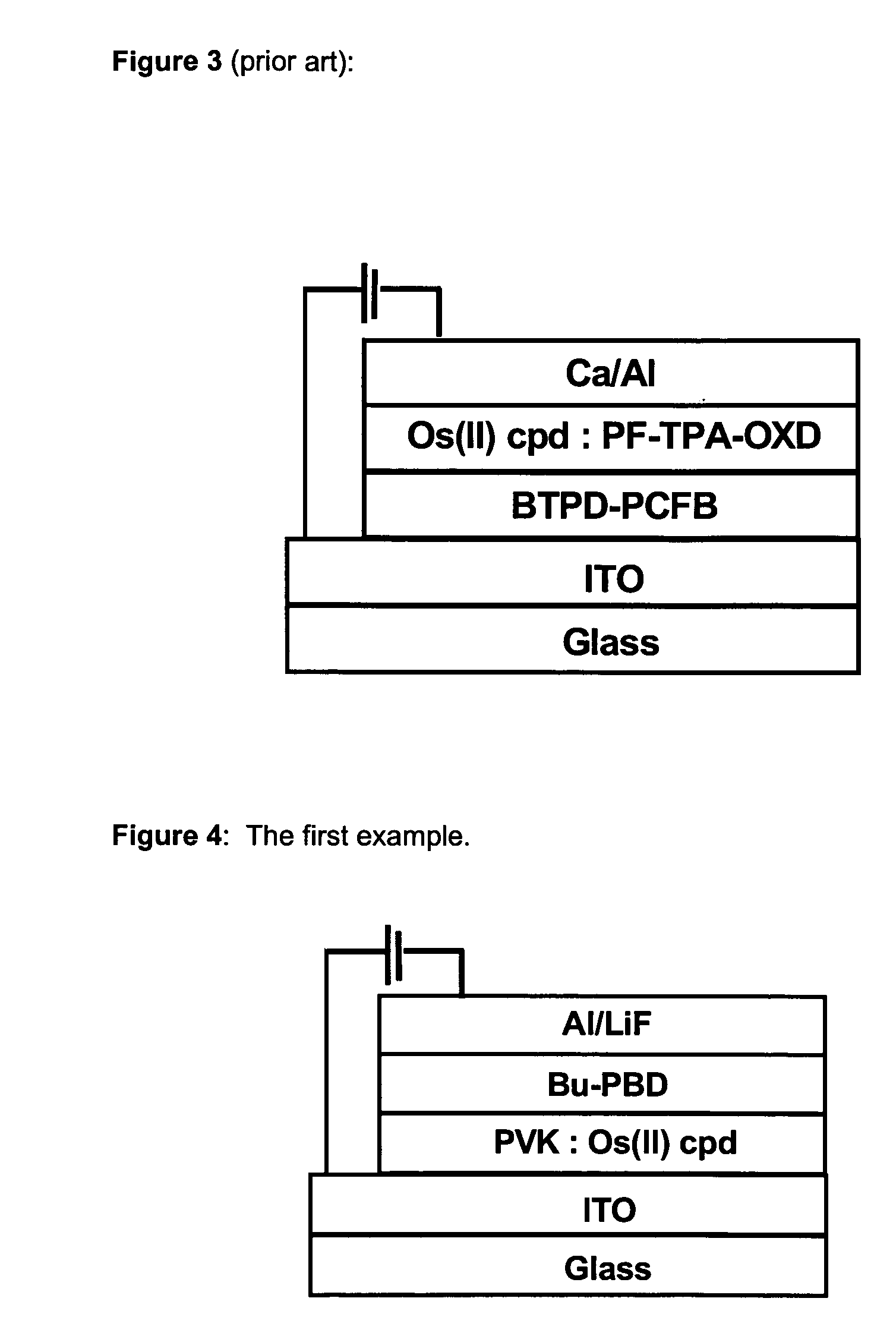Phosphorescent Osmium (II) complexes and uses thereof
a technology of phosphorescent osmium and complexes, which is applied in the field of phosphorescent compounds, can solve the problems of low efficiency, poor viewing angle, and lcd technology
- Summary
- Abstract
- Description
- Claims
- Application Information
AI Technical Summary
Benefits of technology
Problems solved by technology
Method used
Image
Examples
example 1
Synthesis of [Os(fppz)2(CO)2]
[0057] To a 50 mL reaction flask, it was charged with 3-trifluoromethyl-5-(2-pyridyl) pyrazole (fppzH, 296 mg, 1.39 mmol), pulverized Os3(CO)12 (200 mg, 0.22 mmol), and 25 mL of anhydrous diethylene glycol monoethyl ether. The solution was maintained at 180˜190° C. for 24 hours. After then, the solvent was evaporated and the solid material was sublimed under reduced pressure (300 mtorr / 210° C). The sublimate was further crystallized from a mixture of CH2Cl2 and hexane, giving the product [Os(fppz)2(CO)2] as colorless needle-like crystals (267 mg, 0.40 mmol) in 60% yield.
[0058] Spectral data: MS (EI, 192Os): m / z 672 (M+), 616 (M+—2CO). IR (CH2Cl2): ν(CO), 2043 (s), 1973 (s) cm−1. 1H NMR (500 MHz, d6-acetone, 294K): δ9.17 (ddd, JHH=6.0, 1.5, 1.0 Hz), 8.20 (ddd, JHH=8.0, 8.0, 1.5 Hz), 8.10 (ddd, JHH=8.0, 1.5, 1.0 Hz), 7.48 (ddd, JHH=8.0, 6.0, 1.5 Hz), 7.10 (s). 13C NMR (125 MHz, d6-acetone): δ177.6 (CO), 157.1 (CH), 155.8 (C), 151.7 (C), 144.1(q, 2JCF=35.5...
example 2
Synthesis of [Os(fmpz)2(CO)2]
[0059] 3-Trifluoromethyl-5-(4-methyl-2-pyridyl) pyrazole (fmpzH, 240 mg, 1.04 mmol) and finely pulverized Os3(CO)12 (150 mg, 0.165 mmol) were loaded in a 25 mL Carius tube and degassed. It was then sealed under vacuum and placed in an oven maintained at temperatures 180˜185° C. for 2.5 days, during which time its color changed gradually from light yellow to red-brown and finally to orange yellow. After stopped the reaction, the tube was cooled, opened and the content was dissolved in acetone. The insoluble material was filtered off, and the filtrate was dried under vacuum and the residue was sublimed (0.24 torr, 220° C.). The product was then subjected to recrystallization in CH2Cl2 and hexane, giving [Os(fmpz)2(CO)2] as colorless needle-like crystals (34 mg, 0.048 mmol) in 29% yield.
[0060] Spectral data: MS (EI, 192Os): m / z 700 (M+), 644 (M+—2CO). IR (CH2Cl2): v(CO), 2041 (s), 1970 (s) cm□1. 1H NMR (400 MHz, d6-acetone, 294K): 8.97 (d, JHH=6.0 Hz), 7.9...
example 3
Synthesis of [Os(bptz)2(CO)2]
[0061] To a 50 mL reaction flask, it was charged with 3-t-butyl-5-(2-pyridyl) 1,2,4-triazole (bptzH, 273 mg, 1.35 mmol), pulverized Os3(CO)12 (200 mg, 0.22 mmol), and 25 mL of anhydrous diethylene glycol monoethyl ether. The solution was maintained at 180° C. for 24 hours. After then, the solvent was evaporated and the residue was washed with water. The crude product was crystallized from a mixture of acetone and hexane, giving [Os(bptz)2(CO)2] as colorless block-shaped crystals (309 mg, 0.48 mmol) in 72% yield.
[0062] Spectral data: MS (EI, 192Os): m / z 651 (M+), 591 (M+—2CO). IR (CH2Cl2): v(CO), 2041 (s), 1970 (s) cm−1. 1H NMR (400 MHz, acetone-d6, 298K): δ9.16 (dd, JHH=6.8, 1.2 Hz), 8.25 (ddd, JHH=7.4, 6.8, 1.2 Hz), 8.10 (dd, JHH=7.4, 1.2 Hz), 7.55 (ddd, JHH=6.8, 7.4, 1.2 Hz), 1.12 (s, tBu). Anal. Calcd for C24H26N8O2Os: C, 44.43; N, 17.27; H, 4.04. Found: C, 44.26; N, 17.60; H, 4.30.
PUM
| Property | Measurement | Unit |
|---|---|---|
| internal quantum efficiency | aaaaa | aaaaa |
| internal quantum efficiency | aaaaa | aaaaa |
| temperatures | aaaaa | aaaaa |
Abstract
Description
Claims
Application Information
 Login to View More
Login to View More - R&D
- Intellectual Property
- Life Sciences
- Materials
- Tech Scout
- Unparalleled Data Quality
- Higher Quality Content
- 60% Fewer Hallucinations
Browse by: Latest US Patents, China's latest patents, Technical Efficacy Thesaurus, Application Domain, Technology Topic, Popular Technical Reports.
© 2025 PatSnap. All rights reserved.Legal|Privacy policy|Modern Slavery Act Transparency Statement|Sitemap|About US| Contact US: help@patsnap.com



